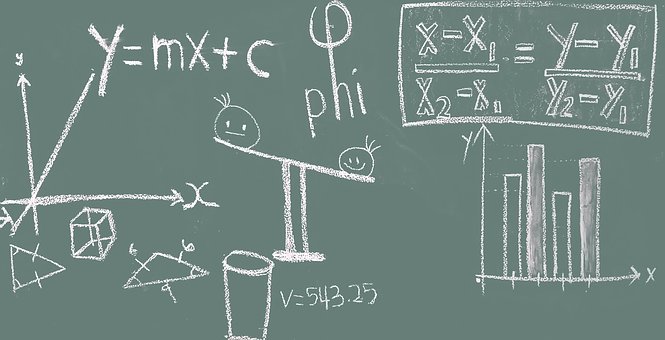
If Hayley takes the GMAT three times and scores 750, 770, and 800, respectively, what is her mean score? You probably won’t get a statistics question that’s quite that easy on the GMAT, but the good news about GMAT statistics questions is that they test mostly simple concepts. You don’t need to know any complicated formulas or equations to master statistics for GMAT quant questions, but you do need to develop a solid understanding of descriptive statistics principles.
In this article, I’ll give you an overview of what’s tested in GMAT statistics questions, define the four key definitions you need to know, and give you tips for mastering statistics questions. I’ll also walk you through two GMAT statistics sample questions. And, as an added bonus, I’ll offer up a range of terrible statistics puns. (Get it?) By the end of this article, you’ll have mastered statistics for GMAT!
What’s Tested in GMAT Statistics Questions?
Many test takers are intimidated by statistics questions on the quant section, particularly the notorious GMAT standard deviation problems. However, GMAT statistics questions are much simpler than they’re often believed to be.
There are typically between four and eight statistics questions on the GMAT quant section. But because questions on the GMAT quant section often combine more than one type of math, you may see basic statistics principles (like mean) pop up in other types of questions, too.
Statistics for GMAT are mainly concerned with finding the center and the spread of a set of values.
Not sure how or what to study? Confused by how to improve your score in the shortest time possible? We've created the only Online GMAT Prep Program that identifies your strengths and weaknesses, customizes a study plan, coaches you through lessons and quizzes, and adapts your study plan as you improve.
We believe PrepScholar GMAT is the best GMAT prep program available, especially if you find it hard to organize your study schedule and don't want to spend a ton of money on the other companies' one-size-fits-all study plans.

Mean and median are the terms that we use to find the center of a set of values. The center of a set of values helps us understand the middle and the average of that set of values.
Range and standard deviation measure the spread of a set of values. Just like the term implies, the spread of a set of values is all about how far the values are spread out from each other. Range is a very simple way for determining spread. Standard deviation is a much more complicated measure of spread. I’ll talk about what all of these terms mean in the next section.
The 5 Key Definitions for GMAT Statistics Questions
There are five key definitions you need to know in order to master GMAT statistics problems.
Mean
You find the mean, or average, of a set of values by dividing the sum of the values in a data set by the number of values.
How do we find the mean?
Well, consider the data set 5, 10, and 15. To find the mean of this data set, first you would find the sum of all values, which is 30 (5 + 10 + 15 = 30). Next, you would divide 30 (the sum of all the values) by 3, which is the number of values in the data set.
The mean of that data set is 10.
Median
The median is the middle number in a set of values. Here’s how you find the median of a data set.
First, consider the data set: 5, 3, 4, 1, 2.
Order the numbers from smallest to largest.
1, 2, 3, 4, 5.
3 is the middle number, which means the median is 3.
What about if you have an even set of values, such as 5, 4, 1, 2?
Order the numbers from smallest to largest.
1, 2, 4, 5.
Find the sum of the two middle numbers (4+2 = 6).
Divide the sum of the two middle numbers by 2 (6/2 = 3).
3 is the median of that data set.

Mode
The mode is the value in a data set that appears most frequently.
Consider the data set 2, 2, 3, 4, 4, 4, 5, 6, 7, 7, 8.
The number 4 appears three times in the data set. It appears the most.
The number 4 is the mode of that data set.
Range
The range of a set of values is the difference between the maximum and minimum values of that set.
For instance, in the set 100, 150, and 200, you would find the range by subtracting the minimum value (100) from the maximum value (200).
The range of that set of values is 100, then.
Want to improve your GMAT score by 60 points?
We have the industry's leading GMAT prep program. Built by Harvard, MIT, Stanford, and Wharton alumni and GMAT 99th percentile scorers, the program learns your strengths and weaknesses and customizes a curriculum so you get the most effective prep possible.

Standard Deviation
Standard deviation GMAT questions often trip up test takers. But GMAT standard deviation questions actually test a relatively simple concept.
Standard deviation measures how far the values in a data set are away from the mean (in other words, the deviation from the mean).
Let’s break down what that means.
In order to find standard deviation, you need to first calculate the mean. Let’s start with the data sets {0, 2, 4} and {1, 2, 3}.
We find the mean of each of these data sets by finding the sum of the data sets and dividing by the number of values in each data set. Both data sets have a mean of 3.
If we look at the first data set, {0, 2, 4} we can see that the numbers are more widely spread away from the mean (3) than the numbers in the data set {1, 2, 3}. That means that the standard deviation for {0, 2, 4} is greater than the standard deviation for {1, 2, 3}.
There’s a four step process for finding standard deviation. I’ll talk about that later when I give you tips for mastering GMAT statistics questions. Until then, make sure you solidly understand what the concept of standard deviation is.

Tips for Mastering GMAT Statistics Questions
GMAT statistics questions can seem intimidating. But don’t worry! These four tips will help you get a better mean score on your GMAT quant practice.
#1: Learn These 4 Rules for Standard Deviation GMAT Questions
Standard deviation GMAT questions often seem incredibly tricky. To make matters worse, standard deviation often pops up in data sufficiency questions, which are tricky enough on their own. However, there are several rules that you can memorize to help boost your understanding of standard deviation.
If every value in a data set is equal, they all equal the mean. That means the standard deviation is zero. This is the lowest possible standard deviation you can have. You can’t have a negative standard deviation.
If you change the values of the numbers in your data set by adding or subtracting the same number to each value, the standard deviation will stay the same. Basically, if you have a set of values such as {1, 2, 3} and add 5 to each value so that you get the set {6, 7, 8}, your standard deviation will be exactly the same for both sets.
Multiplying always changes the standard deviation of a set of numbers, unless you’re multiplying by 1 or -1. If you’re raising the numbers by a power, that always changes the standard deviation as well.
Adding new numbers to a set changes the mean, and thus the standard deviation. There can be exceptions to this rule (if the numbers line up just right), but it will generally be the case.
#2: Understand the Standard Deviation Formula
As I mentioned before, it’s not necessary to know the standard deviation formula in order to solve GMAT statistics questions. However, developing an understanding of how the standard deviation formula works will help you quickly solve standard deviation GMAT questions by giving you a clearer sense of how the different values involved (standard deviation, mean, and variance) relate to each other.
Want to Identify YOUR GMAT Strengths and Weaknesses?
Our proprietary GMAT Diagnostic Assessment creates a customized study plan for you that takes you from registration all the way to test day! It is included with every account and proven to significantly maximize your score.
Get your personalized assessment as part of your 5 day risk-free trial now:

I won’t go through the full standard deviation formula, but it’s helpful to understand the basic steps:
- Find the mean of a set of values.
- Find the differences between each value and the mean.
- Square all the differences and take the averages of the differences, which gives you the variance.
- Find the square root of the variance.
Because it’s the square root of the variance, standard deviation is often a weird number. Remember, the GMAT won’t ask you to calculate anything you can do easily by hand, so you won’t need to use this particular four-step process. Rather, familiarize yourself with the concept behind it (finding the mean and the dispersion from the mean) to increase your understanding of standard deviation.
#3: Understand the Effect of Changing Numbers on Value Sets
Adding numbers to your data set doesn’t just affect the standard deviation. It can also affect other statistical measurements, such as the mean, mode, median, and range.
If you add another number to your data set, your mean will almost always be affected. The key exception is if the value added is equal to the mean — in that case the mean will stay the same.
If you add another number to your data set, but it’s greater than the minimum and less than the maximum value, your range will not be affected.
Adding numbers may also affect your median and mode, but it occurs on a case-by-case basis.
Make sure you recalculate each of these values if you’re solving a multi-part question where you introduce a new value to a certain set.
#4: Remember That The Numbers Will Work Out
As I mentioned before, the writers of the GMAT know that you’re not allowed to use a calculator on the quant section. That means that you’ll be able to solve every question using your mastery of fundamental math concepts, a pencil, and scratch paper. If you find yourself calculating an extremely long decimal, you’re probably going down the wrong path. Remember that you’ll be looking mainly for whole number answers, or simple fractions or decimals. If it’s anything more than that, it’s wrong.

GMAT Statistics Questions Examples
In this section, I’ll walk you through how to solve a sample problem solving and a sample data sufficiency statistics questions.
Problem Solving Statistics Question
A researcher computed the mean, the median, and the standard deviation for a set of performance scores. If 5 were added to each score, which of these three statistics would change?
- The mean only
- The median only
- The standard deviation only
- The mean and the median
- The mean and the standard deviation
This question is a prime example of why it’s important to master your statistics fundamentals. For this question, we need to focus on how adding numbers affects the spread and the center.
Let’s look at mean first. Adding 5 to each score would increase every single score, which means that the mean will definitely change. Knowing that, we can automatically rule out answers B and C, which don’t include the mean.
Now let’s look at the median. If we add 5 to each score, we will also change the median, because the set of scores will be completely different.
That means that our correct answer is D. The median and the mean will both change.
But before we move to the next question, let’s talk about why the standard deviation won’t change.
Standard deviation has to do with the spread of numbers. If we add 5 to each score, every number is increasing by the same amount (5). That means that the spread will be exactly the same, since every score has increased by 5.
Data Sufficiency Statistics Sample Question
A report consisting of 2,600 words is divided into 23 paragraphs. A 2-paragraph preface is then added to the report. Is the average (arithmetic mean) number of words per paragraph for all 25 paragraphs less than 120?
- Each paragraph of the preface has more than 100 words.
2. Each paragraph of the preface has fewer than 150 words.
- Statement (1) ALONE is sufficient, but statement (2) alone is not sufficient
- Statement (2) ALONE is sufficient, but statement (1) alone is not sufficient
- Both statements TOGETHER are sufficient, but NEITHER statement ALONE is sufficient
- EACH statement ALONE is sufficient
- Statements (1) and (2) TOGETHER are NOT sufficient
Let’s start by understanding what the question is asking us. The information tells us that the original 23 paragraphs have a total of 2,600 words. It also asks if the average number of words per paragraph is less than 120, once the two ancillary paragraphs are added.
If the word count is less than 120 per paragraph, then the total number of words in the essay would be less than 25 (number of paragraphs) times 120 (average number of words per paragraph), or 3,000 words.
If the original 23 paragraphs had a total of 2,600 words, that means that the two new paragraphs can only have a total of 3,000 – 2,600 words, or 400 total words, or an average of less than 200 words per paragraph.
Now, since this is a data sufficiency questions, let’s evaluate each statement by itself first
The information provided in statement (1) implies that the total number of words in the 2 added paragraphs is more than (2)(100) = 200. Therefore the number of words could be 201, or the number of words could be 500. This statement is not sufficient, because, our total number of words could be way greater than 400. This statement is not sufficient.
The information implies that the total number of words in the 2 added paragraphs is less than (150)(2) = 300, which is in turn less than 400. The statement is sufficient. The correct answer is B.

Review: What You Need to Know for GMAT Statistics Questions
GMAT statistics questions focus on five major topics: mean, median, mode, range, and standard deviation.
Mean and median are concerned with the “center” of a set of numbers.
Range and standard deviation are concerned with the “spread” of a set of numbers.
The best way to approach GMAT statistics questions is to deeply understand these fundamental principles and how to apply them to complicated scenarios.
What’s Next?
We have the guides to cover every type of content that you’ll see on the GMAT quant section. Our comprehensive guides give you overviews of each section, as well as provide you with sample questions that show you how to apply the tips we’ve discussed. Check out our guides to GMAT geometry and GMAT percentages to start.
The GMAT, unlike other standardized tests, doesn’t allow you to bring a list of formulas or rules to test day. GMAT idioms guide to start boosting your understanding of the essential math concepts you need to memorize before test day. Our downloadable PDF will aid your memorization.
Want to switch gears? We have in-depth guides to help you master the GMAT verbal section, as well. Get an in-depth guide to idiomatic language in our GMAT idioms guide, or learn the tips and tricks you need to ace the verbal passages in our guide to mastering the GMAT verbal.
 PrepScholar GMAT
PrepScholar GMAT
